
The linkup, which she nicknamed “Zamboni the Rinc,” included hard-trad benchmarks like 'The Evictor' (5.12d R) and 'Musta’ Been High' (5.13c R/X).
The post How Lynn Anderson Fired Off Eldorado Canyon’s Hardest, Scariest Trad Climbs—in a Single Day appeared first on Climbing.
]]>
Rincon Wall, high above Eldorado Canyon, Colorado, is an anomaly, with clean, monolithic rock, laser-cut corners and arêtes, and consistent angles, with few of the ledges and rotten purple bands that typically plague the canyon. Not surprisingly, Rincon has, since the 1970s, been a hotbed for hard trad climbing, with notoriously thin free climbs protected by notoriously thin gear going up in the 5.11 to hard-5.13 range. The Central Buttress is the main event, with a dozen-odd gently overhanging single-pitch routes on brilliant red-orange sandstone in the 5.12 to 5.13 range, including hard-trad benchmarks like The Evictor (5.12d R) and Musta’ Been High (5.13c R/X).
On April 27, 2023, the Boulder, Colorado–based climber Lynn Anderson sent ten 5.11 to 5.13+ routes—all of which she’d previously redpointed—on the Central Buttress as a personal challenge, testing herself on the wall’s thin crimps, technical laybacks, bouldery cruxes, and infamous runouts over micro gear. The linkup, which she nicknamed “Zamboni the Rinc,” went as follows: Center Route (5.11a PG), Camouflage (5.12c sport—the only fully bolted climb on the list), The Evictor (5.12d R), ‘Fraid Line (5.13a R), Surf’s Up (5.13a PG), Musta’ Been High (5.13c R/X), Freeline (5.13b PG-13), Freakline (5.12a PG-13), Climb of the Century (5.11b PG-13), and Wendego (5.12a R). Anderson had made two prior attempts on Zamboni the Rinc—on April 12 and April 18—but both days got too warm and sunny, and Anderson fell on Musta’ Been High after sending the first five routes before that. She finally put the link together on April 27, a cloudy, windy spring day.
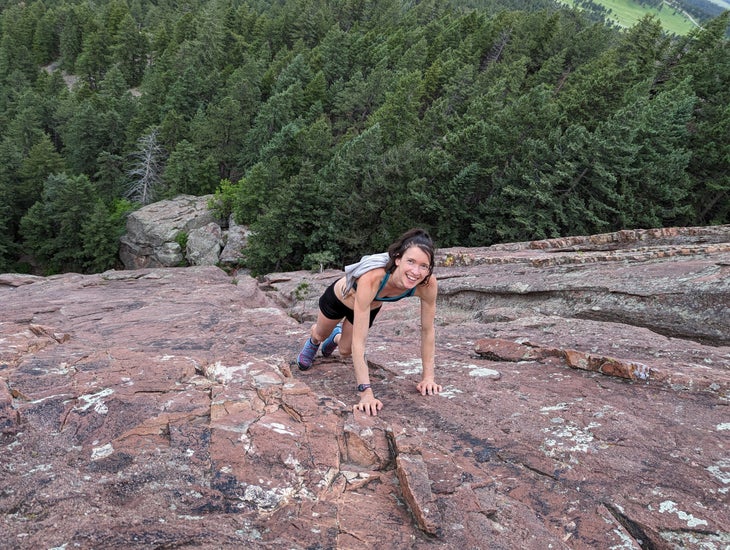
Although Anderson, 26, is a relative newcomer to climbing—she’s only been at it for five years—she has in that short time amassed an impressive ticklist, including a redpoint last August 31 of the fearsome and technical The Honeymoon Is Over (V 5.13c) on the high-altitude Diamond of Longs Peak, Colorado, as well as other hard climbs at crags around Boulder. Anderson, who grew up in California and Wisconsin, began climbing at the University of Wisconsin-Eau Claire, where the school had a small climbing wall.
“I was an NCAA Division 3 gymnast and didn’t have much free time, but I figured climbing was something I could do once I was done with gymnastics,” says Anderson. After graduating, she moved to Colorado, lured by outdoor sports, but soon found herself “way more into climbing than anything else.” Out in Colorado, Anderson has cobbled together a living working at Whole Foods, as a nanny, and as a personal assistant, and is currently enrolled in a program to earn her certificate in data science. With her gymnast’s background, she is lithe and flexible on the rock, and people often mistake her for taller than her 5’6”. Anderson is moreover a dedicated athlete, who can be found putting in long, no-nonsense sessions on the fingerboards and MoonBoard at the Boulder Rock Club.
Like Timothy Kang’s epic at day on December 5, 2022, at the Buttermilks, California, during which he linked up five of the area’s biggest, hardest highballs/free solos—Footprints (V9), Ambrosia (V11), Too Big to Flail (V10), This Side of Paradise (V9), and Evilution Direct (V11); all climbs he’d done before—Anderson’s day at Rincon involved doing multiple difficult climbs with intrinsic danger. The physically hardest, Musta’ Been High, was first led in 2001 by Eric DeCaria, and involves punchy laybacking along a radically overhanging fridge feature protected by thin pro, including a Ball Nut and a Knifeblade. Its difficult neighbors to the right—especially Free Line and The Evictor—aren’t much safer, with fussy gear, big runouts, and tenuous climbing, and have been the scene of gear-ripping groundfalls. All of which begs the question, why return to these climbs, knowing how hard and dangerous they are, to lead them in a single day?
The Interview
Climbing: How did the idea for the linkup come to be?
Anderson: I first climbed at Rincon in June 2020 when I flashed Center Route as my first 5.11 trad [laughs]. I remember trying Evictor on toprope thinking it was a hilarious joke that anyone would lead it, and even more absurd that anyone would climb the other routes there. But during November and December 2020, just after moving to Boulder, I met a psyched and wonderful crew stoked on Evictor and ‘Fraid Line, and started chipping away at Evictor. It was my first real “project” and the hardest route I’d done at the time. I also realized how weak my fingers were, because I wanted to work ‘Fraid Line next, but couldn’t even pull onto the starting holds, let alone do one move on [the thin, opening V6] boulder problem. That was my motivation to start hangboarding and bouldering.
Climbing: So you’d sent each pitch individually before Zamboni the Rinc, correct?
Anderson: Yeah. I sent ‘Fraid Line and Freeline in spring 2021, Surf’s Up fall 2021, Musta’ and Wendego spring 2022, and finally Camouflage in fall 2022 (I consider that one my “1/32-ass, try-once-a-year, multi-season project”). I kept coming back to Rincon every season (i.e., late fall/early spring) because everyone at the crag was always so welcoming, encouraging, and fun to be around, unlike many sport crags, which sometimes have strange, competitive, ego-centered vibes.
Climbing: What was your motivation to redo all these scary climbs? Why not just walk away, having ticked them unscathed?
Anderson: I wanted to do all the routes in a day because it seemed like the next “seemingly impossible” project for me at the crag. All the routes I’d done there had been milestones and meant more to me than most of my other sends.
Climbing: What specifically made them special?
Anderson: Evictor was my first project, and the hardest route I’d done. I’d never really projected something like that before—when I started, I couldn’t do a lot of the moves and I didn’t really think I’d be able to do it. Eventually, I put it together, and that was kind of a breakthrough. A funny thing is that those routes at Rincon were my first of the grade—and the first routes at those grades I really projected. Evictor was my first 12+. ‘Fraid Line was my first 13a. Free Line was my first 13b. Musta’ Been High was my first 13c. They were all just milestones, plus I love the crag.
Climbing: You mentioned you fell on Musta’ Been High? Isn’t that basically a “no-falls” route?
Anderson: There are a couple places you don’t want to fall, and it depends on whether the Knifeblade [at the first crux] holds. I took some test whips onto it that weren’t very big, and I was like, ‘If this fails, I’ll be caught by a bomber purple TCU without hitting the slab.’ For pins in Eldo, it looked pretty solid, so I trusted it.
Some people don’t place gear after the pin until they finish the second crux, but I probably wouldn’t have led it if there was absolutely no gear, because then you’re doing the second crux with the pin 10 feet below you. But I place a blue Ballnut from a kneebar and then do a couple more moves and then place a blind gray TCU—a Metolius double 00—which I ripped once [while trying the route in March 2022]. It’s the only piece of gear I’ve ever ripped, but the blue Ballnut held!
The first day [I tried the linkup], I made it past the first crux and fell on the second crux—and I was actually caught by two lobes of the Metolius 00. The second day, it was supposed to be nice and cloudy but then all of a sudden the sun came out, so two moves into the first crux I sweated off and took a little fall on the Knifeblade.
Climbing: Why that order of the climbs? What was your strategy?
Anderson: I have to be warmed up, so Center Route was a good warmup. Camouflage, because it’s so thin, I like to do it when it’s cooler. And then Evictor was a good second warmup. And then ‘Fraid Line and Surf’s Up, just to get them out of the way—those feel pretty high-percentage to me, and they also helped me get warmed up. But I also didn’t want to do Musta’ Been High and then fall on ‘Fraid Line or Surf’s Up—in other words, I didn’t want to have to lead Musta’ Been High unless I had an actual shot at the linkup. My plan for the day I sent was, if I didn’t get Free Line [the seventh route on the list] in two or three tries, I was going to say, “Screw it and just finish on Climb of the Century and Wendego and call it good enough.
Climbing: Was the day you did it a no-falls day?
Anderson: Almost. I fell on ‘Fraid Line—my foot slid out of a foot jam. It was so unexpected. But that was the only fall.
Climbing: Has anyone else, to your knowledge, done this linkup before?
Anderson: I’d seen the film Safety Third and knew Brad Gobright had sent all the 5.13s at Rincon. [Editor’s Note: Alex Honnold also flashed or onsighted all the routes on the Central Buttress, except for Musta’ Been High, over a two-day period in winter 2009.] I hadn’t heard of anyone else doing it, but I’m sure it’s been done. It seems like climbing the section of wall from Musta’ to Camouflage is an obvious linkup … like Jurassic Park at Dinosaur Rock. To me, it seems that for every “sponsored pro” spraying about everything they climb, there are multiple other insanely strong climbers doing crazy-hard stuff and never telling anyone. So, I’m guessing others have done it before.
Climbing: How did you train mentally for the linkup?
Anderson: Mostly I just realized I had to start leading the routes again. I toproped them a lot and felt really good on them. But the first time I went to lead ‘Fraid Line again, I was so gripped and tried way too hard. I was, like, ‘Oh, I need to start leading these too,’ because my head was so used to toproping. It took getting used to leading headier routes again.
Climbing: How did you train physically for the linkup?
Anderson: I’d do things like lead or toprope ‘Fraid Line and Surf’s Up with minimal rest. So, like, do one and then toprope the other or lower down and do the Surf’s Up crux while I was pumped. Also, bouldering inside and hangboarding.
Climbing: What was the biggest mental crux of the send day?
Anderson: I feel like I was more jittery the first day, and then there was the second day, and the third day I wasn’t too hopeful because the forecast was pretty bad—but it ended up working out. I wasn’t even sure if could have a good go at it, but I was also kind of sick of it so maybe I was in the ‘I don’t give a fuck’ mentality.
Climbing: What did you learn from Zamboni the Rinc, either about yourself or about the sport?
Anderson: When I first thought of the linkup, I thought, ‘Oh, that won’t be impossible. I’ve already done all of these routes. Now I just have to do them again.’ And then I started working them, and I was like, ‘Oh, they’re still hard.’ Even though I’d done them once before, they were still really hard.
***
Zamboni the Rinc: All 10 Routes
Here is the order in which Lynn Anderson sent the linkup, as well as a little information about each route. All climbs are around 80 feet long.
- Center Route (5.11a PG); FA: Larry Dalke, Roger Dalke, 1965; FFA: Chris Reveley, Scott Woodruff, Dan Hare, 1976: This friendly pitch has sinker gear but a strenuous crux (and crux placements) moving up laybacks above a roof capping the initial corner.
- Camouflage (5.12c); FA: Dan Michael, Bill Myers, Paul Piana, 1987: Matchsticks and pebbles up a blank, 88-degree wall, to a crux on even smaller matchsticks.
- The Evictor (5.12d R); FA: Dale Goddard, 1985: Most of the R rating comes in the initial 5.11a section branching left off Center Route, but the in-your-face crux sequence is hard all the way to the anchors—and the gear placements are weird, technical, and shallow.
- ‘Fraid Line (5.13a R); FA: Topher Donahue, with Jim Belcer, 2002: This climb, Surf’s Up, and Free Line all share the same opening V6 boulder problem, a weird cheater-stone start yarding on credit-card crimps to establish in a smooth dihedral, the “sentry box.” From here, ‘Fraid Line goes straight up a thin seam and crimpy headwall, taking RPs for protection.
- Surf’s Up (5.13a PG); FA: Charlie Fowler, Patrick Meek, 1986: The same boulder-problem start, then moving left into a second, difficult crux to reach a thuggy, intermittent layback crack.
- Musta’ Been High (5.13c R/X); FA: Eric DeCaria, 2001: Well-protected 5.10 leads to the radically steep “fridge feature,” which demands power, precision laybacking, and technical kneebarring. The small gear has held falls—but there’s not a lot of it to speak of once you’re motoring along the fridge.
- Free Line (5.13b PG-13); FA: Ron Olevsky, rope solo, 1975; FFA: Justen Sjong, 2000: Shared V6 boulder-problem start into a short section of jamming, then a committing traverse rightward to finish on the upper half of The Evictor—navigating its crux while pumped.
- Freakline (5.12a PG-13); FA: Brenton Kreiger, 2021: Climbs the runout bottom half of The Evictor into the runout top half of ‘Fraid Line, swapping physical cruxes for mental ones.
- Climb of the Century (5.11b PG-13); FA: Alec Sharp, Casey Newman, Jeff Butterfield, 1980: A classic bouldery, slippery Eldo crux on thin gear down low leads to sustained crimping up a striking corner.
- Wendego (5.12a R); FA: Pat Ament, Larry Dalke 1964; FFA: Jeff Achey, Kevin Bein, Barbara Devine, 1980: A smooth corner with microscopic holds and desperate palming surfaces perma-slathered in chalk. Upward-driven pins protect the crux down low. If they hold, great; if they don’t, you’ll fall into some of the pointiest, nastiest talus around.
Matt Samet is a longtime climber and outdoor journalist based in Boulder, Colorado.
Also Read
- Janja Garnbret Stays Perfect at Villars World Cup; Emma Hunt Surges to another American Speed Record
- Cameron Hörst Declares ‘Martial Law,’ New 5.15a on Mt. Charleston
- Five Easy Exercises to Heal Tight Wrists and Fingers
The post How Lynn Anderson Fired Off Eldorado Canyon’s Hardest, Scariest Trad Climbs—in a Single Day appeared first on Climbing.
]]>
Here are the coolest new lines (and repeats) of late.
The post New Sends We Cared About: FA’s of a V15 and One of the World’s Hardest Trad Routes; Bolger Sends Another 5.15a appeared first on Climbing.
]]>
In an attempt to make space for the newsworthy ascents that occur with ever-increasing regularity, we’re launching a new weekly series in which we try to celebrate a few outstanding climbs that for one reason or another caught our attention. We hope you enjoy it.—The editors.
Aidan Roberts Makes FA of Swiss V15
The 24-year-old Brit needed only three days to FA Unison (V15), in Ticino, Switzerland. Roberts, who made the second ascent of Alphane (V17) last fall, grew up in Northern England’s Lake District. Since the pandemic, he’s made the transition from World Cups to outdoor climbing, and has systematically been sending some of the world’s hardest lines.
Roberts first spotted the line of Unison during an initial trip to the area a year ago. At the time, it seemed impossible, so he forgot about it until last fall when Shawn Raboutou remarked on its potential. Roberts returned to Ticino this past February and went to work—he began cleaning the line on his first day of arrival. The landing was a bit concerning, so the next day, with help from Giuliano Cameroni, James Pearson, Tom Peckitt, and Luke Murphy, Roberts crafted a log platform. The group gave the boulder a few rips before sundown, and Roberts sent the next day.
Vladek Zumr, who witnessed the send, described the climb: “It is kind of a high and steep boulder problem with really small crimps, with which you have to be very precise, and you need to have enough strength to do the topout. … The crux is definitively the precise movement on the crimpy middle/upper section.”
On Instagram, Roberts commented that Ticino has started to feel like “home,” and, “With this has come the satisfaction of feeling to help develop an area which has offered me so much.”
View this post on Instagram
For most of us mere mortals, V15 is an unfathomable grade, but for Roberts it’s hardly worth mentioning. In addition to sending Alphane, he’s made quick work of numerous V15 and V16’s. And because earlier this year Roberts set a replica of Nalle Hukkataival’s Burden of Dreams using scans and 3D printed holds, well, we’re watching. There really aren’t too many climbers we’d bet might send the infamous Finn line, but Roberts’s track record speaks for itself.
P.S.: Faster than we can get this news out, Roberts has sent another no-doubt challenging line: Innocent Man, FA’ed by Niky Ceria. He declined to comment on the grade, however based on the two’s capacity for ticking cutting-edge boulders, we suspect it’s well-worth the mention. —Delaney Miller
Ignacio Mulero FA’s One of the World’s Hardest Trad Routes
A 40-foot boulder is now home to one of the hardest trad routes in the world: El boulder del pedal (5.14c) in La Pedriza, Spain. Ignacio Mulero told 8a.nu that he initially envisioned bouldering out the entire pitch (the V14 crux is in the first 16 feet and protected with crash pads) but a conversation with Nalle Hukkataival, who was also projecting the line, convinced him to not needlessly add danger to his ascent.
El boulder del pedal now joins the ranks of the hardest proposed trad climbs in the world, including Magic Line, The Recovery Drink, Meltdown (all 5.14c); and Empath, a bolted line which Connor Herson did on gear last year and proposed 5.14d. Not included in this list of “world’s hardest” are the deliberately ungraded Tribe and Bon Voyage, both speculated to be at least as hard as Empath.
Mulero’s first ascent caps a successful season at La Pedriza, where in January he also made the first free ascent of the 50-foot Snoop Dogg (5.14a), also on gear. Mulero is enroute to Annot, France, to surely sample some of its trad-climbing goodness, before heading to Norway to try The Recovery Drink.—Anthony Walsh
Tom Bolger Repeats Yet Another 5.15a
View this post on Instagram
There was a time when 5.15a was cutting edge—but that was a long time ago. Nowadays, climbs like La Rambla and Jaws II and Biography see an indecent number of ascents each year; a friend of mine, who’s climbed 5.15a, isn’t even the strongest climber at his gym…. So why do I think that Tom Bolger’s second ascent of Maya, a 5.15a in the El Purgatori sector of Margalef, is worth a brief acknowledgement here? Two reasons:
Reason #1: I admire Tom Bolger.
I’ve been a quiet fan (a.k.a. Instagram creep) of Bolger’s for years now. At first this was largely because I couldn’t understand how someone (him) could do things like weighted front levers on the 20mm monos on the Beastmaker 2000—holds I’m not even sure I can safely hang. But the more I learn about Bolger, the more I admire his choices in life. He’s not even close to the world’s strongest sport climber, and at 35 years old he never will be; and yet he has nonetheless structured his life around his love for Spanish limestone, relocating from the UK to Catalunya, where he now climbs and develops new climbs and rents guest houses to visiting climbers. And I guess I think there’s something very commendable about identifying your dream life and pursuing it.
Reason #2: Maya was first climbed by… Ramon Julián.
The fact that Maya was FA’d by Ramon Julián Puigblanque in 2016 and went unrepeated until now is significant. Why? Because Ramonet, as he’s often called, may be the single most prolific sandbagger of the modern era.* Even if Maya is “only” 5.15a, as Ramonet first suggested and Bolger seems to confirm, trying an unrepeated Ramonet route takes some nerve—a willingness to check your ego at the door, which is something that, quite frankly, not all pro climbers are willing to do. So I think that even trying Maya is commendable and that confirming its grade is news.
View this post on Instagram
*The nerds among you may remember when, back in 2016, Jens Larsen sparked a typically raucous debate on 8a.nu by claiming, in a one-paragraph op-ed, that “Ramonet is the toughest FA grader in the world.” But though Larsen was perhaps too cavalier about his statement, and though he did a pretty lazy job trying to back it up, I don’t think he was entirely wrong. Last week, while working on a piece about Jorge Diaz-Rullo’s recent 5.15c FA in Margalef, I heard a rumor (which I haven’t verified) that when Adam Ondra first tried Ramonet’s 2013 route Mejorando Imagen (for which Ramonet proposed 5.14d), Ondra thought it was harder than Chris Sharma’s famous 5.15b First Round, First Minute. And when Alex Megos finally made the second ascent, in 2021, he confirmed Ondra’s feelings by proposing that exceedingly rare thing: the double upgrade. Want more evidence that Ramonet’s routes are hard? Just scroll through the comments on his latest Instagram post. You’ll find some very famous climbers openly joking about his grades. —Steve Potter
Also Read
- New Sends We Cared About: One of Patagonia’s Hardest Free Routes Gets an FA (and more)
- Meet the Turkish Mountain Guides Who Helped Rescue Earthquake Survivors
- New Book ‘More’ is an Unflinching Look into Climbing and Motherhood
The post New Sends We Cared About: FA’s of a V15 and One of the World’s Hardest Trad Routes; Bolger Sends Another 5.15a appeared first on Climbing.
]]>
As winter slowly draws to a close, the crusty old trad-moms and -dads are crawling out of their caves, dusting off the rusty rack of iron, and beginning to rave about “The good ol’ days.” While they can’t help with the crust, Backcountry.com is here with great discounts to help these old tradsters trade in … Continued
The post Deal of the Week: Tradsters appeared first on Climbing.
]]>
As winter slowly draws to a close, the crusty old trad-moms and -dads are crawling out of their caves, dusting off the rusty rack of iron, and beginning to rave about “The good ol’ days.” While they can’t help with the crust, Backcountry.com is here with great discounts to help these old tradsters trade in their rusty iron for some new-age gear.
Black Diamond Camalot C4 Package #.3-6
$728.60 (10% off, was $809.50)
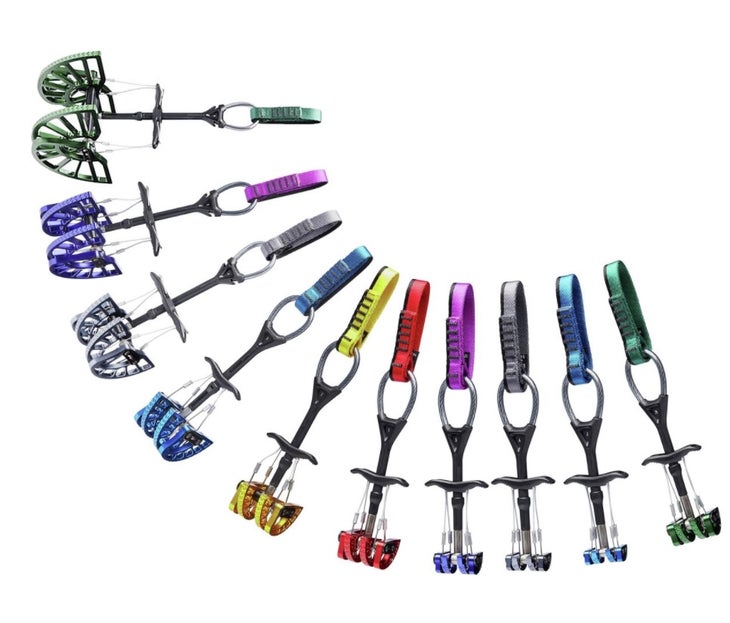
For generations, Black Diamond has been at the forefront of climbing protection technology. Their newest line of C4s are 10% lighter than the preceding iteration, without sacrificing any strength of functionality. This package features the entire line—10 cams in total—however, Backcountry.com is offering discounts on a wide variety of cams and packages.
View the Camalot C4 Package #.3-6 at backcountry.com
Mountain Hardwear Alpine Light 28L Backpack
$175.47 (35% off, was $269.99)

When you’re looking at a long day in the big mountains, having a strong summit pack is essential. The Alpine Light 28L Backpack is large enough to fit everything you need—food, water, layers, extra gear, etc.—while its ergonomic design allows for unencumbered movement on the wall. It’s constructed with a burly polyester blend to ensure it can take a beating.
View the Alpine Light 28L Backpack at Backcountry.com
Edelrid Canary Pro Dry Climbing Rope
$194.96 (25% off, was $259.95)
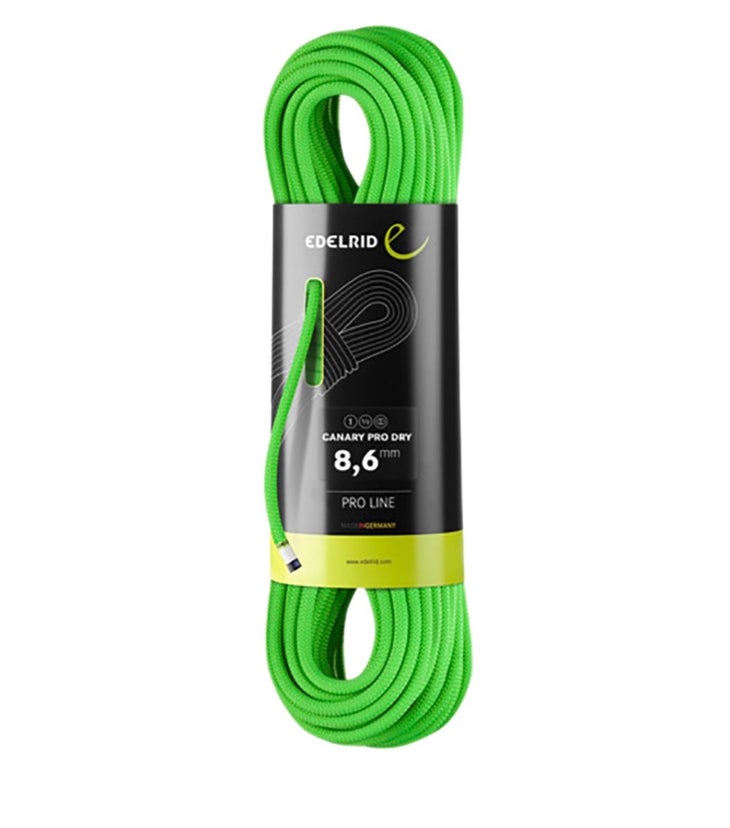
This is Edelrid’s skinniest climbing rope, certified as a single, half, and twin. It is an ideal cord for big days in the hills when you’ve got a lot of walking to and from the climbing—this thing is feathery light compared to thicker climbing ropes. It also has a Pro Dry treatment to protect it from water, dirt, and abrasion.
View the Canary Pro Dry Climbing Rope at Backcountry.com
Mammut Neon Light 12L Backpack
$52.50 (25% off, was $70)
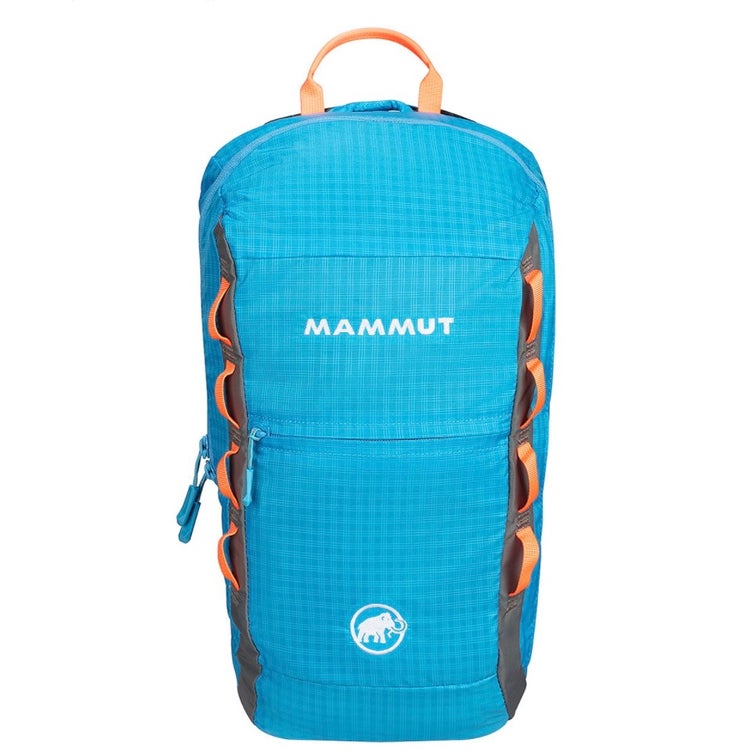
For not-so-long days in the mountains when you still want to bring a few creature comforts along on the climb, the Neon Light 12L Backpack is a great option. It is large enough for food and water, but small enough to be barely perceptible during the climb. The internal pockets offer organization of your personal items, while the exterior daisy chain offers additional options for lashing gear.
View the Neon Light 12L Backpack at Backcountry.com
Edelrid Mega Jul Belay Device
$34.46 (25% off, was $45.95)
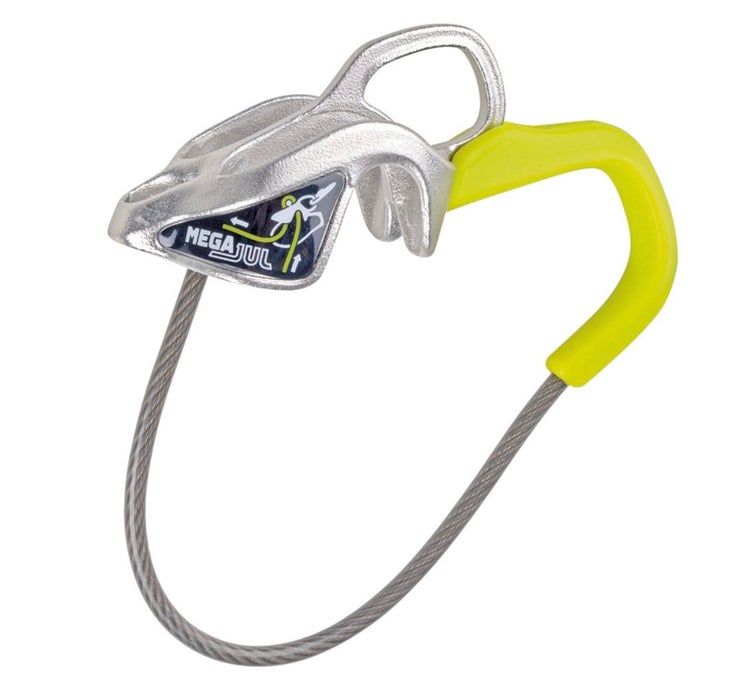
For such a small belay device, the Mega Jul packs a punch. It is a stainless steel assisted braking tube style device. The assisted braking feature gives you and your climber a little extra peace of mind while leading, but this device can also attach directly to the anchor in guide mode and has assisted braking on rappels.
View the Mega Jul Belay Device at Backcountry.com
La Sportiva TX2 Approach Shoe
$97.50 (25% off, was $130)

For getting out there, way out there, you need a shoe that is light on the feet but provides stable and grippy footing on all terrain. Enter the TX2 approach shoe. The TX2 is the lightest on La Sportiva’s legendary TX line, and has a Vibram Megagrip Rubber outsole to ensure traction on both flatland and steep scrambles alike. Best of all, when it’s time to climb, their thin profile easily packs down into your pack or hangs off your harness.
View the men’s TX2 Approach Shoe at Backcountry.com
View the women’s TX2 Approach Shoe at Backcountry.com
Edelrid Mission II Carabiner 6-Pack
$56.21 (25% off, was $74.95)
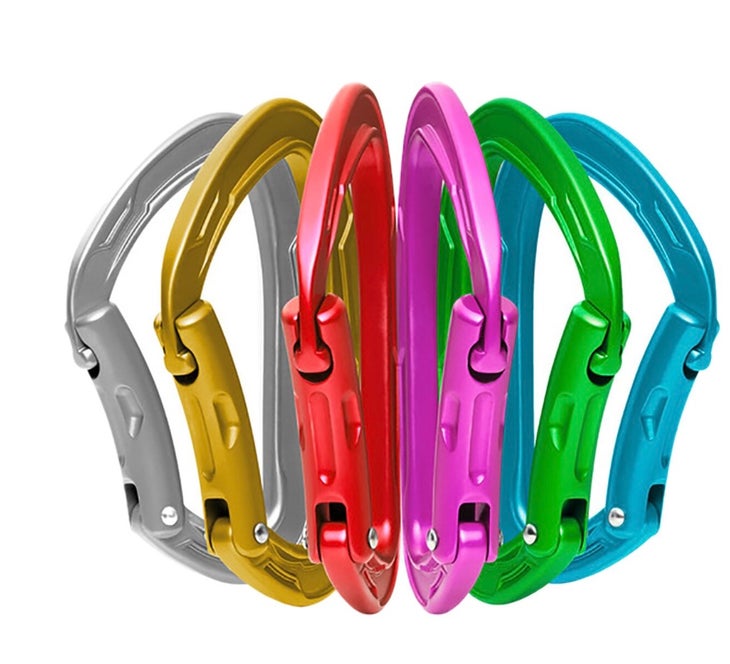
Having a set of lightweight, color-coded carabiners can totally transform your trad rack. With colors corresponding to your cams, choosing the right piece off your harness as you’re pumping out will be much less horrific. And weighing in at just over 1oz per carabiner, the Mission II’s will be hardly noticeable on your rack.
View the Mission II Carabiner 6-Pack at Backcountry.com
Electric Bickle Sunglasses
$87.96 (20% off, was $109.95)

How can you tell who is a trad climber at the party? Don’t worry, he’ll tell you. He’ll also likely be wearing a sick pair of shades the the Electric Bickles here. Polarized for functionality with a bodacious shape and red tint for excellent style points. You’re a trad climber. You love to stand out.
View the Electric Bickle Sunglasses at Backcountry.com
The post Deal of the Week: Tradsters appeared first on Climbing.
]]>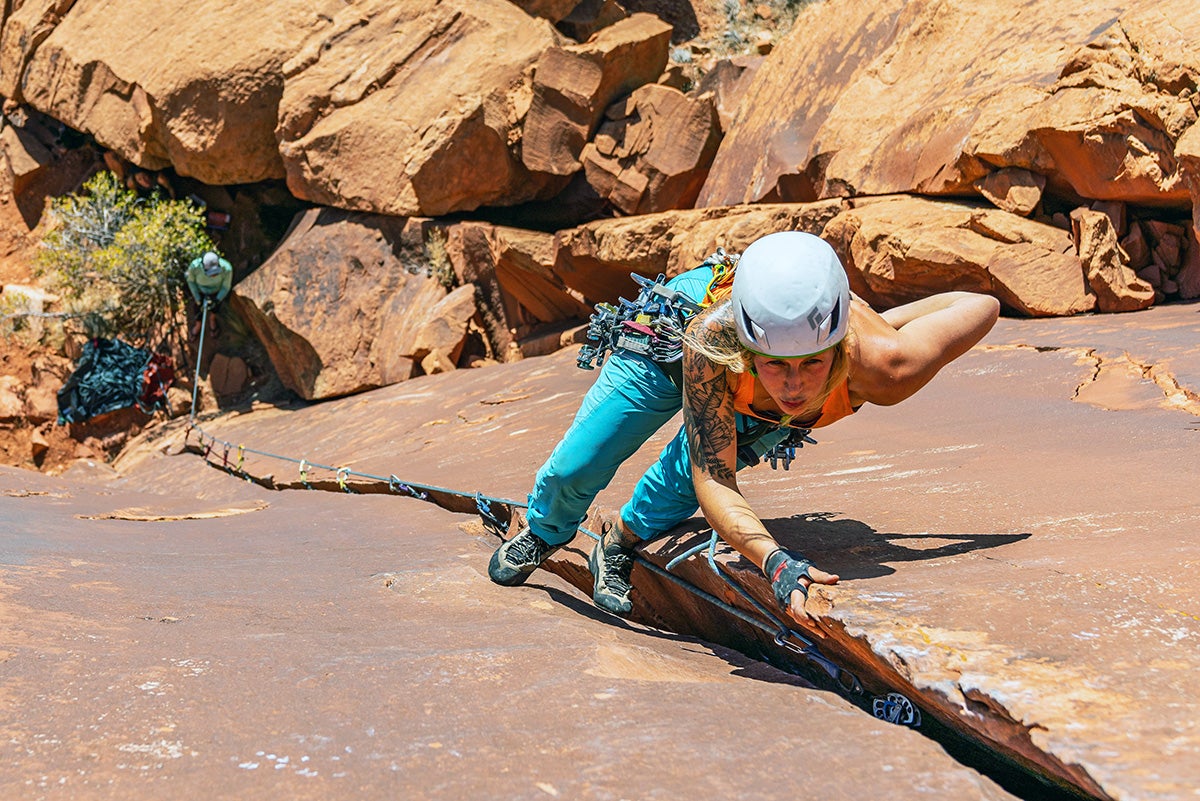
Trad Climbing Doesn't Have a Bolt to Protect Every Other Move, and How You Sew Up a Pitch Can Be a Matter of Life and Death, or at Least Life and Being Seriously Gripped.
The post Gear Guru: How Often Should You Place Climbing Protection? appeared first on Climbing.
]]>
[To see more of Zach Joing’s great climbing photography, go here. Joing took the excellent photo you see that opens this column.]
Question: I’m new to trad climbing, and I want to know whether I should place gear at even distances, say every six feet, or run it out more and place two pieces of pro close together every 12 feet.
Gear Guru says: The decision depends as much on your confidence level as it does math and physics. More so, perhaps.
The first variable to consider is rock quality. In Grade A El Cap granite, a cam in a textbook placement isn’t going to pull. A #0 or #00 cam it might break, however. In Grade F desert sandstone and even the B stuff of The Creek, cams can and do rip out. Considering whether a small cam might break or larger ones pull goes into your “gut feeling” folder, but more on that later.
The second variable is your mental and physical condition. Psychologically, you will be more confident—less likely to fall—when you closely space pro. Typically, this will have you setting a cam or nut, and climbing until it is just under your feet, then reaching high and slamming in the next piece. This system effectively gives you a toprope half of the time, empowering a weak mind and wobbly arms. Placing pro with such frequency is, of course, taxing and you could flame out and deliver yourself to the Hand of Fate.
Running it out, on the other hand, is the wave to your sand castle. As you get higher and higher above your last piece you confidence can wash away. Those of sound mind and strong arm can shrug at runouts.
So far we have assumed that the gear and rock are solid, and have neglected the all-important variable of having or not having a stance. For argument’s sake, we will ignore this point because if there’s a stance and hanging on and plugging gear is not a big deal, then put it in!
You also must consider your rack. Do you have enough cams or nuts to place one every six feet? A 40-meter pitch laced up that way would take 20 placements. Do you have 20 pieces? And do those 20 pieces fit the 20 placements? The answer to both is probably “no,” so you’ll naturally need to run it out in a few spots to either economize your gear or to get to a placement that fits.
Let’s imagine now that you are at your special home crag, where the rock is bullet only in your mind. This is where leading gets interesting, or confusing since it involves math, physics, logic, and the Tibetan Calendar of Inauspicious Days.
In the scene where you set gear roughly every body length, you will fall 12 feet (you were six feet above the gear) onto it. When it fails, you then fall 24 feet onto the next placement (12 feet of rope out above that piece).
Running it out is the wave to your sand castle. Confidence washes away.
The problem you face is what smart people call a “self-similar pattern.” With the rock and the placements being similar, when one placement fails, all placements will probably fail—if anything, once the top piece pulls, the lower ones are more likely to also zipper because the fall distance and impact force increase. Bummer, because you thought you were being safe.
The way to prevent this is to break the pattern with a positive variable. Put two pieces in one place, for example.
The variables might not make a difference, but they might. On Earth, there will be positive (and negative) factors. The ability to climb safe means being able to evaluate rock and placement integrity and wisely use your knowledge. That, more than worrying about how often you should place gear, might keep you out of harm’s way.
Question: A question, as I contemplate buying gear for leading. I know that most manufacturers rely on planned obsolescence for continued sales. Is this a strategy used by climbing-gear makers? I imagine that such a practice would be dangerous. If these companies don’t employ this strategy, how do they make money?
Gear Guru says: Planned obsolescence, notes The Lightbulb Conspiracy, is the “secret mechanism at the heart of our consumer society,” and typically occurs in an oligopoly, such as we have with climbing gear. “Shortening the replacement cycle” would be a profitable strategy if it weren’t for gravity and the high cost of product-liability insurance. Forgetting those nuisances for a moment and assuming that climbing gear is made to need frequent replacing, something has gone terribly wrong—I’m still plugging cams from the 1970s, and I could use (if I wanted) my carabiners and nuts from the same era.
Rather than planned obsolescence, climbing gear is subject to the obsolescence of desirability—I could climb on that old rack, but I don’t want to because it would be heavier and wouldn’t work as well as today’s new gear. In the words of the industrial designer Brooks Stevens, I have “the desire to own something a little newer, a little better, a little sooner than is necessary.”
Dynamic obsolescence drives the invention of lighter and stronger ropes, more ergonomic ice tools, stickier and better-fitting shoes, and more stylish helmets. Whether manufacturing and selling climbing gear is profitable is beyond my knowledge, but I imagine that are some ducats filling pockets since we have an entire economy supporting the sport.
The post Gear Guru: How Often Should You Place Climbing Protection? appeared first on Climbing.
]]>